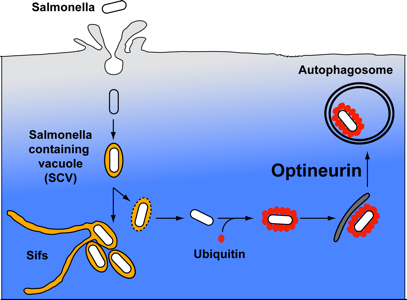News Archive
New defense mechanism against Salmonella elucidated
27 May 2011. After infection, Salmonella usually accumulates in contained vacuoles inside cells. However, a small percentage of bacteria escape these compartments and start rapidly replicating in the cytosol, a mechanism which is viewed as important for dissemination of the disease to new hosts. This uncontrolled proliferation in the cytosol can be prevented by an evolutionary conserved process called autophagy. Cytosolic Salmonella are recognized, surrounded by a membrane vesicle and marked for degradation via the lysosome.
An international group of scientists around FMLS director Ivan Dikic has now discovered a new molecular link for this recognition of Salmonella by the autophagy membrane. They showed that the protein Optineurin functions as inducible autophagy receptor which is activated by phosphorylation. It binds to ubiquitinylated Salmonella as well as to the autophagosomal membranes, thereby selectively delivering the Salmonella to the autophagy clearance pathway. It is proposed that the phosphorylation of autophagy receptors represents a general mechanism for the regulation of autophagy processes which are operational e.g. in neurodegenerative disease to remove protein aggregates or in cancer development.

Link to abstract, to German or English press release.
Contact
Ivan Dikic
Institute of Biochemistry II
Medical Faculty of the Goethe University
University Hospital Building 75
Theodor-Stern-Kai 7
60528 Frankfurt am Main, Germany
E-Mail: Ivan.Dikic@biochem2.de
Homepage: www.biochem2.com/
Full reference
Philipp Wild, Hesso Farhan, David G. McEwan, Sebastian Wagner, Vladimir V. Rogov, Nathan R. Brady, Benjamin Richter, Jelena Korac, Oliver Waidmann,Chunaram Choudhary,Volker Dötsch,Dirk Bumann, and Ivan Dikic (2011) Phosphorylation of the Autophagy Receptor Optineurin Restricts Salmonella Growth; Science 26 May 2011: 1205405 Published online 26 May 2011 [DOI:10.1126/science.1205405]

